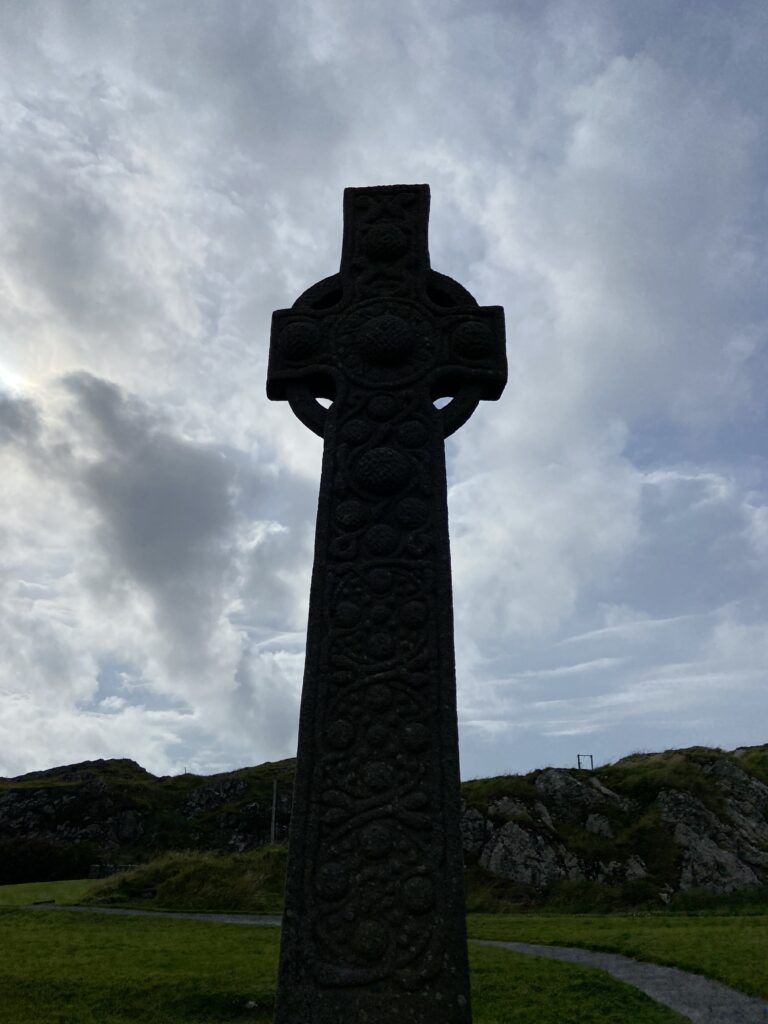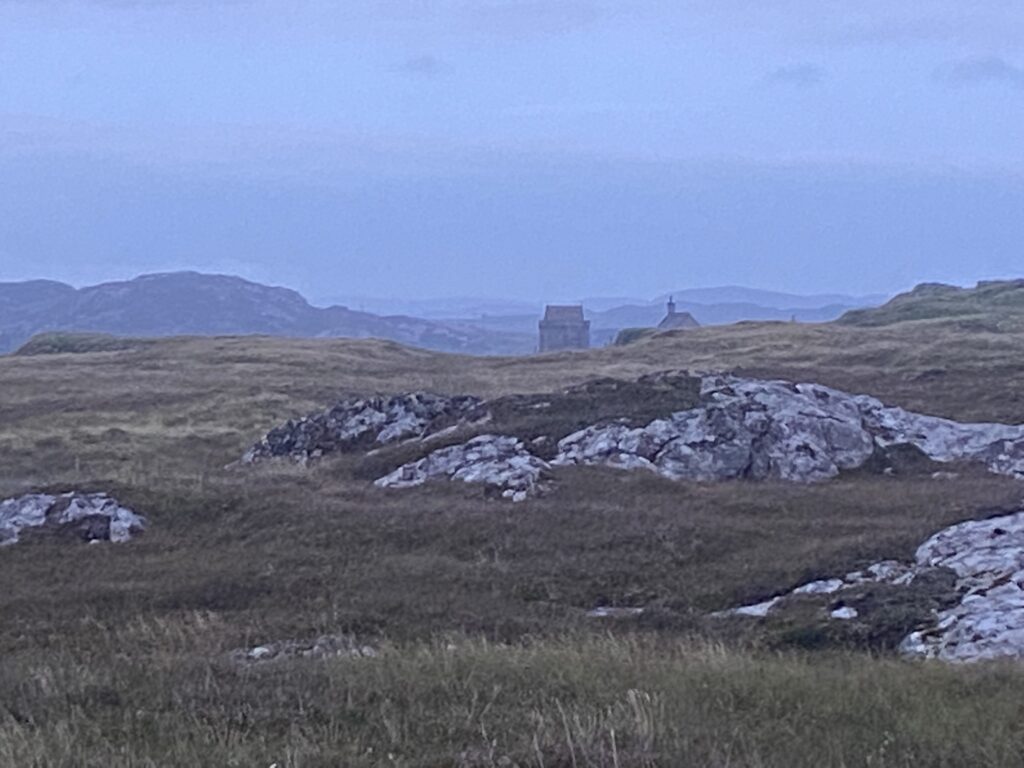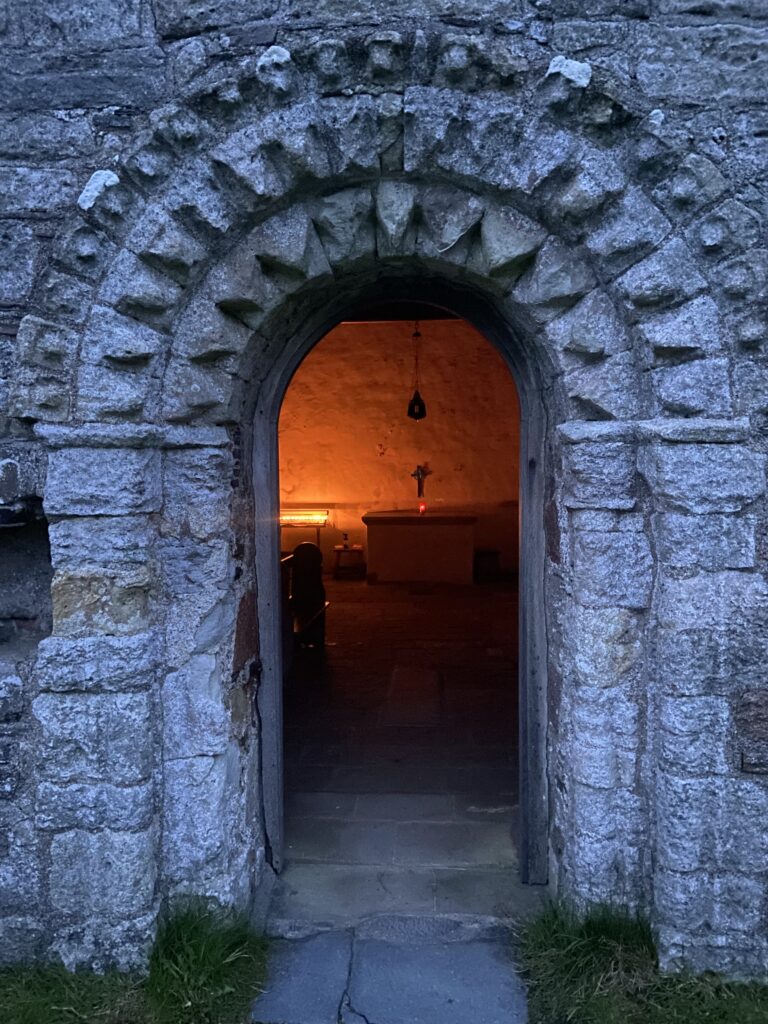
Encounter
Akin to coming to the center of the labyrinth after walking its winding path, encounter, the second phase of pilgrimage, is the moment of arrival. This is the moment when we find what we have set out to seek on pilgrimage, or perhaps, it finds us. The moment of encounter may come at the pilgrimage “destination,” or it may come somewhere along the path, it may be obvious, or it may be subtle. Our job as spiritual pilgrims is not to force the encounter, but to walk faithfully, attentively, and openly, ready to receive it.
Absence
The concept of encounter may provoke some anxiety— “What if I don’t feel it?” In pastoral conversation, I often see the damage of an evangelical expression of faith which seems to promise that when you turn your life over to God, you will feel God‘s constant presence and guidance with you. This has not been the case even for the saints and the mystics. St. John of the Cross, the 16th century Spanish mystic, wrote of a “dark night of the soul.” Mother Teresa experienced this dark night, a sense of separation which she called “that terrible emptiness, that feeling of absence of God.” (Benedictine College)
If you long for God but cannot feel God’s presence, you are in good company. French author George Bernanos in The Diary of a Country Priest said, “The wish to pray is a prayer in itself.” Your longing and your faithfulness to the pilgrim call are testament to the source for which you seek. Can we trust that God wants to meet us even more than we want to meet God? Can we give up our need for any kind of control over our encounter with God, and simply wait for God to find us?
Surrender
The gospel for the second Sunday of Advent always puts John the Baptist center stage, with his fiery message of repentance for confession of sins. These words can feel heavy-handed and judgmental, but repentance, metanoia, in Greek, just means “turning.” Think of the many turns that walking the labyrinth involves, or the about-faces that are required in everyday life, or a conversion—turning one’s life in a whole new direction. A confession of sin is really a confession of need. By admitting to our broken human condition and turning to God, we complete the first three steps of the 12 step program, which has helped millions to spiritual freedom. These steps are often summarized, “I can’t, God can, I think I’ll let Him.” Encounter requires this kind of humble surrender before the Holy.
One way that pilgrims have traditionally practiced surrender is to accept the travails of travel (those words have the same root!) as spiritual teachers. Irish poet-priest John O’Donohue, speaking with Phil Cousineau, author of The Art of Pilgrimage, said, “Beauty may be how we come to love a place. But if we don’t learn to love the journey for itself, including the struggles and obstacles, we will never feel anything when we arrive at our destination. Nothing there will move us as it should.” Cousineau invites readers to, “‘See with the eyes of the heart’ as the Sufis say, and transform the inevitable ordeals of your journey into opportunities to learn something about yourself and the wide world around you.” Whether we are traveling or simply moving through our lives in the world, we will have dozens, perhaps hundreds of encounters everyday—with other people, with nature, culture, technology. Who are we to say that God cannot speak to us through these encounters, even the troublesome ones? They may be, as Mother Teresa said of her work with the poorest of the poor, Jesus in some of his “most distressing disguises.” Can we ask for the grace to see things, people, and situations that trouble us differently?
The Ineffable
Encounter, however, can be more than absence or trouble. O’Donohue in Cousineau bids us to “look for sites and situations where you can feel eternity wrestling with time.” Throughout his book, Cousineau repeats as a refrain the ancient injunction to pilgrims, “Pilgrim, pass by what your heart does not love.” We return to our longings and our response to beauty as an internal compass. Cousineau speaks of the pilgrim’s “irrepressible desire to see deeply into ourselves and the world [which] evokes what Hindus call dyana, ‘the long pure look.’” In similar fashion, Jesuit theologian Walter Burghardt described contemplation as “a long, loving look at the real.” The encounter with the Holy, then, may ask us to use our most finely honed spiritual senses, our own longing and love, to see with new eyes, and to be present with what is.
In 1939 American writer Henry Miller traveled to Greece at the invitation of a friend. He spent nine months traversing the country, taking in its sights, and engaging with its artistic and literary elite. In his travelog The Colossus of Maroussi, Miller wrote, “The light of Greece opened my eyes, penetrated my pores, expanded my whole being.” Cousineau recounts how, in the amphitheater at Ancient Epidaurus, Miller experienced a great peace washing over him. He realized what was needed was “to surrender, so that our little hearts may beat in unison with the great heart of the world.” Miller’s experience of simple presence lead to an encounter with a sense of oneness which for most people would be difficult to put words around—the ineffable. In the presence of Holy, words are both insufficient and unnecessary.
Redirection

From the time I began planning my sabbatical pilgrimage to the United Kingdom, I was drawn to a retreat on Iona as the capstone of my trip. Four nights became two, a stay within the monastery walls was traded for a solitary shepherd’s hut, a preached retreat became 30 hours in chosen silence, but my stay on Iona was the most direct encounter with holiness on my four-month sabbatical, and one of the deepest of my life.
I have heard it said that the stones of this tiny island are some of the most ancient in the world, and that in medieval times an oath “sworn on the stones of Iona” was considered unbreakable. Just three square miles of earth set in an aqua-crystal sea off the western shore of Scotland, Iona is thought by some to have been a holy place among the local tribes before St. Columba and his twelve Irish monks landed there over 1,400 years ago. The monastery was ransacked, fell into ruin, and was rebuilt several times, most recently by a community led by Presbyterian pastor and peace activist George MacLeod beginning in the late 1930’s. When I was there, the global and ecumenical Iona Community was having its members’ retreat, which for me was a bit like walking into someone else’s family reunion. But the place spoke to me in silence over the energy of the gathering, and drew me in deeply.
On the evening of my one full day on Iona, I took a walk away from the village over to the west side. I followed the tourist map I had snapped a picture of, and found my way past increasingly further spaced cottages to an expanse of soft, lush turf overlooking a rock-strewn, white sand beach, with the sun sinking toward the sea. I walked the beach in a kind of ecstasy, completely alone. I saw only four other human beings at considerable distance the entire time I was there. I exclaimed over the beauty, put my toes in the cold water, picked up beautiful stones and stuffed my pocket with trash. And I prayed—I do not remember what—except that it came like a lover’s murmur from the deepest part of my heart. To the northeast there was supposedly a hiking path over the hills that led more directly back to the north side of the village where the abbey lay, in the direction of my accommodations. But it was not expedience nor sense that led me up into those hills (the tourist map had warned against it), but a deep tug of my heart. And perhaps a little hubris (“I’m a country girl! And this island is only a mile wide!”)
It soon became clear that I was, if not quite lost, at least not likely to find a trail. I slogged, literally, up and down hills, through heather growing in bog-like soil, jumping over streams and rivulets that seemed too slippery or deep to step in safely. My shoes were soaked. I had drunk the last of my water. I had slipped and fallen on my behind. And dusk was darkening toward nightfall. It was smack-dab in the middle of the island that fear set in. Too far to go back; no clear way forward. I stopped. And I prayed, doing my best to lay down fear and surrender to the one I had danced with on the beach. “God, I need help.” Immediately clear direction came in the sense of a deeply felt intuition. Instead of heading north-east, where I thought the other end of the trail came into the road, I needed to go directly east, toward the abbey. I could see the top of its tower by then, so these holy directions were easy to follow, though the way was still wet and slippery with a few fences to climb. By the time I reached the gate to the abbey the last worshippers were leaving the compline service I had hoped to attend. A brief exchange with a hostess at a hotel restaurant which could not serve me dinner at that hour warmly reunited me with the human community. I was drawn into the candle-lit cemetery chapel for a prayer of deep gratitude. And then I walked up the star-lit road back to my shepherd’s hut.

Practice
We do not know where, when, or how, and we know from those who have gone before that it may even be in absence, but once we set out on our pilgrim journey, we have a reasonable hope that God will meet us somewhere along the way. Understanding that this is God’s work, these practices may help prepare the ground for that encounter.
Acceptance and surrender. When I think I have learned this lesson for the thousandth time, I find I need to learn it again. William Young in his novel The Shack speaks of the need to “kill our independence.” Even without travel, life brings us daily “travails” enough to practice stopping, accepting what is, and surrendering our will to God’s will. A physical action that can help embody this surrender is taking downward-facing, clenched fists and slowly turning them upward, opening your palms to the sky.
A close cousin to surrender is flexibility. The ability to surrender gives us flexibility to pivot— to literally change course, if needed (remember the turning in repentance? remember my change of direction?) That kind of openness actually opens doors to more synchronicity and meaning in our lives. The more flexible and open we are, the more I believe moments of encounter are likely to arrive, like birds who will come near someone who is still, but will flutter away from someone who stalks them. Flexibility allows us to exist in moments of kairos time—God’s time, graced time— which can overlap with but never be contained within chronological time. Perhaps this is what is meant by “time and eternity intertwined.”
Rainer Maria Rilke wrote, “The necessary thing is great, inner solitude. What goes on inwardly is worthy of your love.” Retreats (in silence, at monasteries whenever possible) have been a cornerstone of my spiritual life all of my adult life. I cannot recommend this kind of pilgrimage highly enough. But only more recently have I come to realize that just as important are the weekly retreat of a sabbath day, the monthly retreat of what the Camaldolese Benedictines call a “desert day,” and especially the daily retreat of quiet prayer time. “Go into your room and shut the door and pray to your Father who is in secret. And your Father who sees in secret will reward you.” (Matthew 6:6)
A last word from The Art of Pilgrimage: “Ancient wisdom suggests if you aren’t trembling as you approach the sacred, it isn’t the real thing. The sacred, in its various guises as holy ground, art, or knowledge, evokes emotion and commotion.”
Prayer
Wise and loving God, you bear us for joy. In humility, you show us wisdom. Enfold us at the hour of our encounter with you with the knowledge born of love. Awaken within us the desire to know rightly and the will to live justly, with grace and generosity. Amen.
Adapted from Daily Prayer for All Seasons
Poetry
tasting mindfulness
have you ever had the experience of stopping so completely,
of being in your body so completely,
of being in your life so completely,
that what you knew and what you didn’t know,
that what had been and what was yet to come,
and the way things are right now
no longer held even the slightest hint of anxiety or discord?
it would be a moment of complete presence, beyond striving, beyond mere acceptance,
beyond the desire to escape or fix anything or plunge ahead,
a moment of pure being, no longer in time,
a moment of pure seeing, pure feeling,
a moment in which life simply is,
and all that “isness” grabs you by all your senses,
all your memories, by your very genes,
by your loves, and
welcomes you home.
Jon Kabat-Zinn


Recent Comments